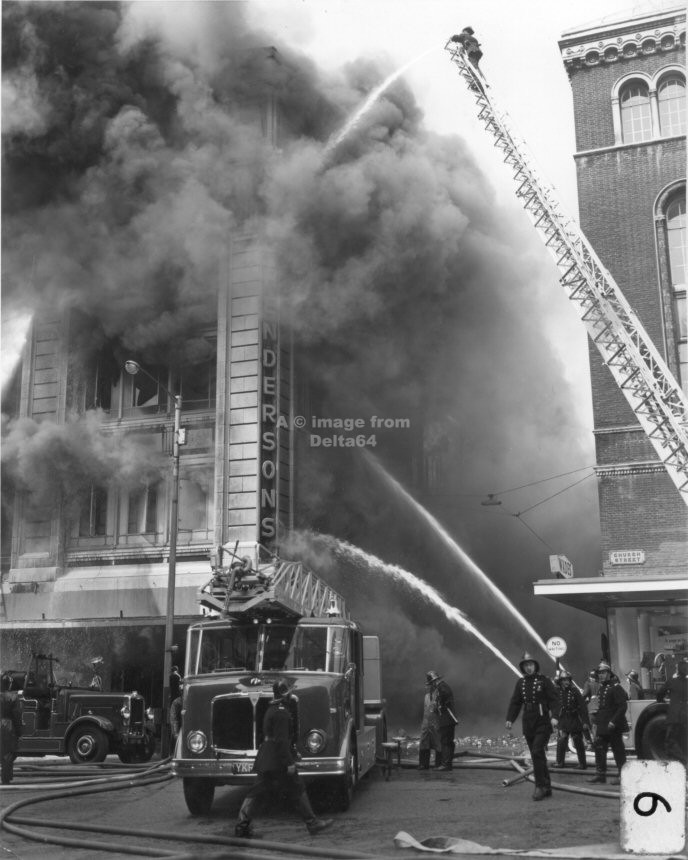
I am most grateful to Simon Ryan, Merseyside Fire & Rescue Service, for all his help in making pictures and narrative available for this page, which has been put here to commemorate the 50th anniversary of what was to become one of the most tragic and yet significant fires of its type in the post-war era. Sadly 11 people died as a result of this incident. It was the worst department store fire in the United Kingdom for many years and the lessons learned became the catalyst for the subsequent passing by Parliament of the Offices, Shops and Railway Premises Act 1962.
As usual I would ask visitors to
respect the copyright of all the pictures used here which have been supplied
from the Merseyside FRS archives.

Whilst the above picture shows the incident very much at its height, I shall endeavour firstly to give a more chronological account in both narrative and pictures.
Wednesday 22nd June 1960 was a very hot day. In those days the majority of towns and cities had a 'half-day', that was one day in the week when most shops closed at lunchtime. Wednesday was 'half-day' closing in Liverpool and Henderson's department store was one of the few stores to remain open. There were in excess of 400 people in the store that afternoon, most of whom were either shoppers or staff.
At 1420, the store's General Manager was on the 3rd floor when he heard a crackling noise above. When he looked up at the suspended ceiling he saw a bright flickering light. Realising there was a fire he contacted the store's telephonist and told her to call the fire brigade. The manager then brought an extinguisher to bear on the fire without effect.
The 999 call was received at the Liverpool Fire Brigade Control in Hatton Garden at 1422. The pre-determined attendance was 2 Major Pumps, 1 Pump Escape and 1 Turntable Ladder. The first appliances were in attendance by 1425 and after an intital assessment, the Office-in-Charge sent an assistance message "Make Pumps 7, Emergency Tenders 1. The Salvage Corps were also informed and attended.
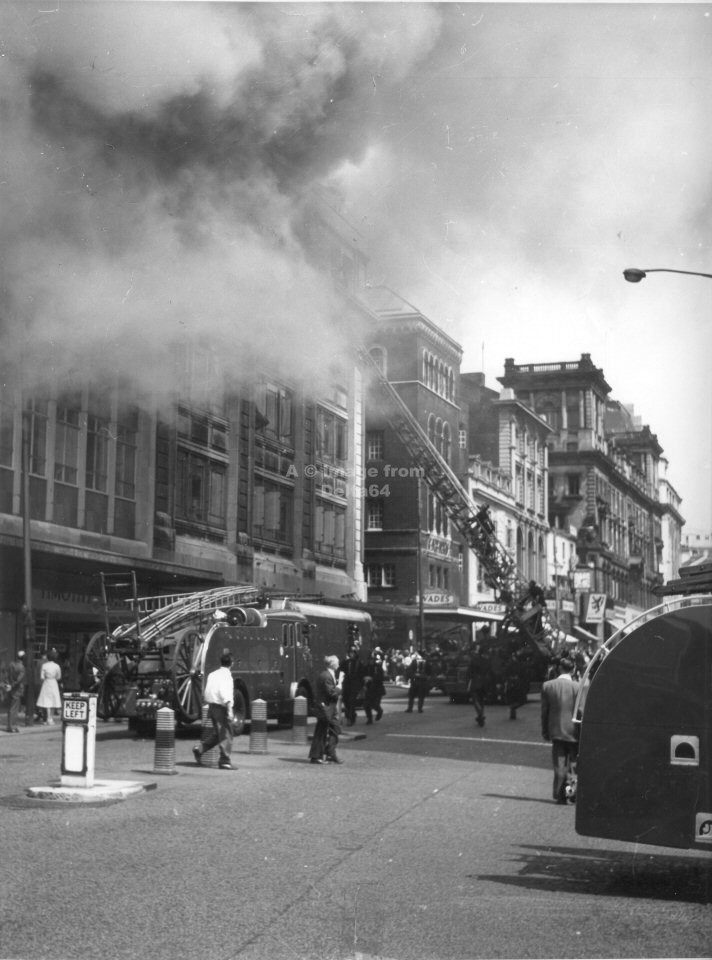
This was the scene at approximately 1430. The Pump Escape was from Essex Street.
The next assistance message was
at 1432 when TLs were made 2. However, with a rapidly deteriorating
situation, a further assistance message was sent at 1434 "Make Pumps 15,
TLs 4". At 1436 the Control Unit and 6 Ambulances were requested.
The Ambulance Service sent similar
assistance messages with a request at 1440 to "Make Ambulances 10" followed
a minute later by an increase to 14.
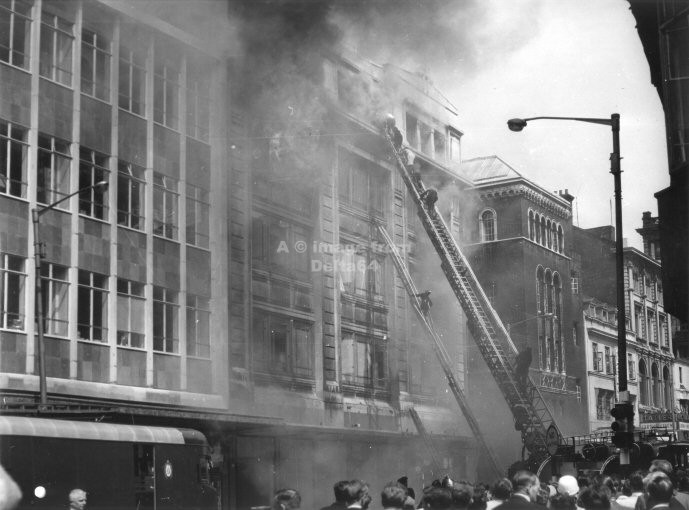
A number of people were rescued via Turntable
Ladder, EKA342, from Hatton Garden.
[This appliance is currently preserved on
Merseyside.]
At 1503 all firemen were withdrawn from the building and soon after a collapse of the centre portion of the front part occurred. Flying embers also caused minor damage to surrounding premises.
By 1510 flames were visible on the 2nd floor and at 1512 pumps were made 20. In order to maintain some cover for the rest of the city only one Liverpool Pump was sent this time. Arrangements under the 1947 Act brought assistance from Birkenhead County Borough, Wallasey County Borough, Lancashire County Fire Brigade and Bootle County Borough each of which sent a Pump.
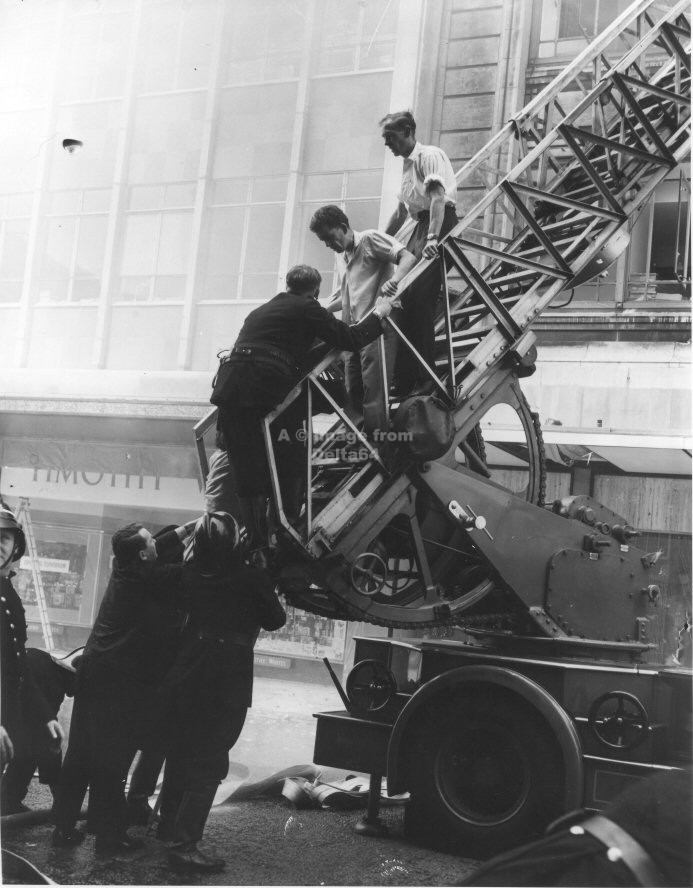
Further rescues from the Turntable Ladder.
The Hose Carrier was requested at 1521 attending at 1527. It laid considerable lengths of hose and brought monitors to increase the weight of the water attack on the flames. Lastly TLs were made 5 at 1542, with the brigade spare [Leyland Metz KF 6683 a 90` wooden TL dating from 1933] attending from Hatton Garden with a scratch crew.
The STOP message was sent by Chief Officer Tom Kelly at 1744. The fire had been extinguished using 5 TL monitors, 6 twinjet branches and 11 main branches with over 1½ million gallons of water used via 65 hydrants. Indeed the demand for water was so great that the Fireboat `William Gregson ` was brought to the Pier Head and used to pump water from the River Mersey via a relay.
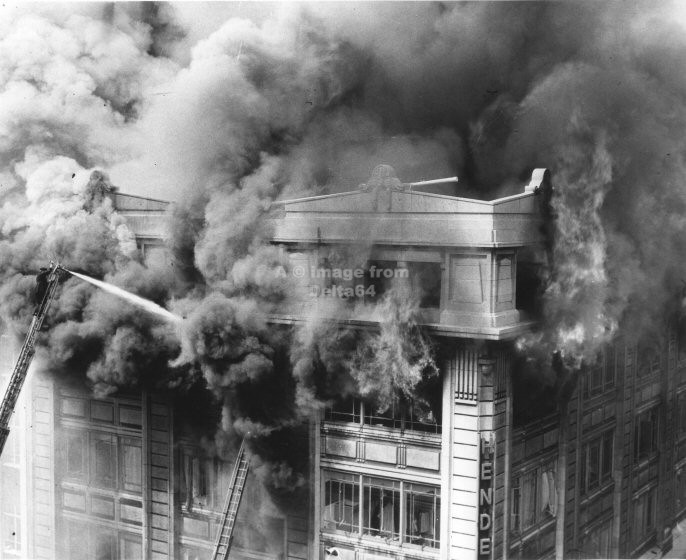
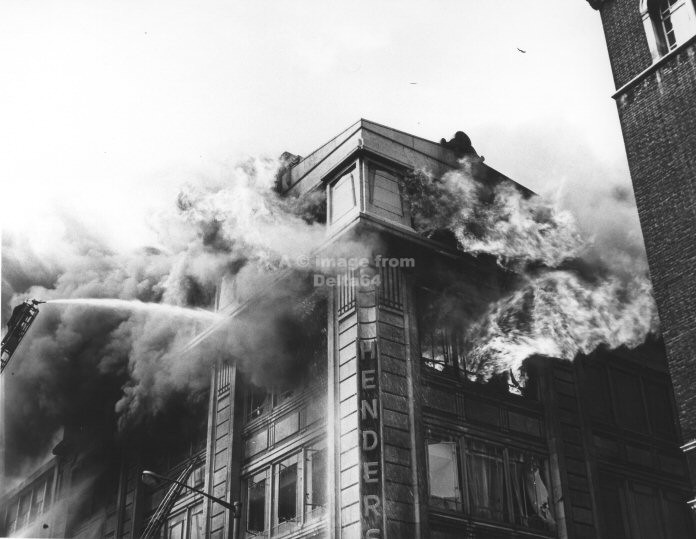
The severity of the fire can clearly be seen in these pictures.
What follows is an extract from the Chief Fire Officer's Annual Report in 1961, to the Chairman and Members of the CITY OF LIVERPOOL FIRE SERVICES COMMITTEE.
On Wednesday, 22nd June, 1960,
one of the most tragic and serious fire incidents for many years, causing
the death of eleven persons, occurred at Henderson's Store in Church Street,
in the early afternoon. On the arrival of the first attendance appliances,
including a turntable ladder, the Officer-in-Charge found the upper section
of the building well alight, with dense smoke and flame issuing from the
upper floors, and six persons were trapped on a ledge on the face of the
building at fourth floor level, one of whom fell from the ledge to the
street below. The turntable ladder was quickly erected to the ledge and
the trapped persons were soon rescued.
As it was also believed that
further persons might be trapped inside the building, reinforcements to
make pumps up to twenty and also the attendance of 5 turntable ladders,
emergency tender, hose carrier and Control Unit were immediately requested,
and the Chief Officer assumed command of firefighting operations. Due to
the extremely rapid spread of fire, the whole of the building soon became
untenable and it was necessary to withdraw very quickly all Fire Service
personnel, some of whom escaped by first floor windows to the street.
The fire was fought until
5.44 p.m. when it was possible to send the "Stop" indicating that the fire
was under control, and following a search of the building when it was safe
to enter, the bodies of ten persons trapped inside the building were discovered
and promptly removed by waiting ambulances to the City Mortuary.
As a result of the damage
which was caused to the building, the remaining structure became completely
unsafe and demolition work was immediately commenced so that Church Street
could be re-opened to traffic as early as possible.
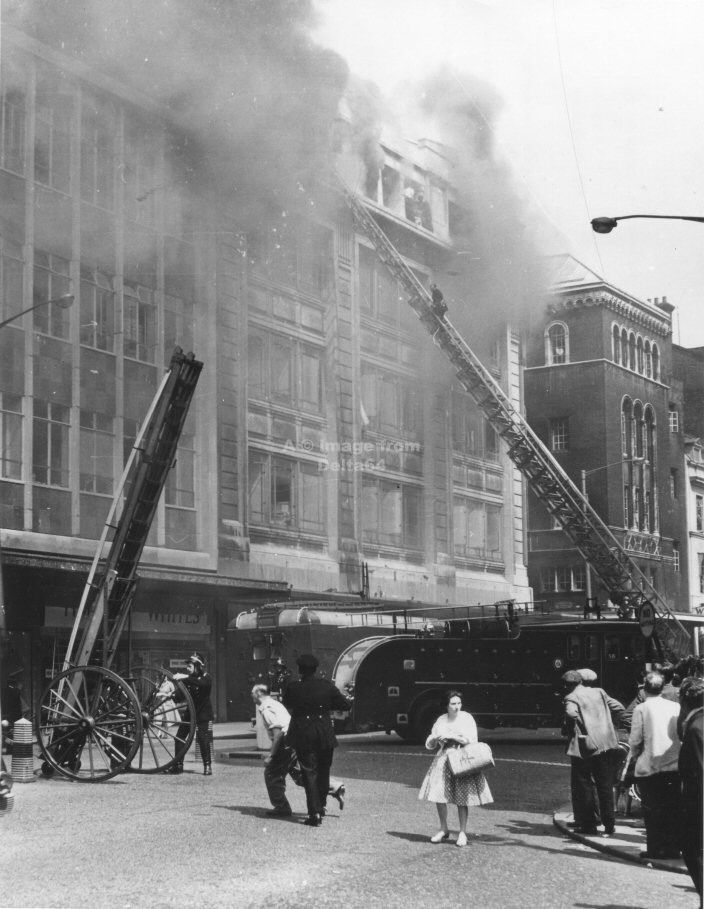
Leading Fireman Taylor can be seen on the Turntable Ladder looking down on the casualty who had just landed on the canopy [above the E.T.]
Colin Murphy, a married man from Wallasey who worked for the Liverpool Ventilation Co, had been working on the 1st floor when the fire started. He went back into the smoke to switch off the ventilation fans, but on being told that they had already been switched off he was then trapped on the 4th floor.. Thereafter he climbed out onto the ledge as all other routes were cut off. It was however a difficult climb as the windows were some distance off the floor. He eventually made his own escape climbed out onto the ledge at the front of the premises. Whilst crawling along the 18`` wide ledge towards Timothy White’s roof and safety a sudden rush of smoke and flame exploded out from a 4th floor window and caused him to loose his footing. Colin fell onto the concrete and glass canopy at ground floor level, receiving injuries from which he later died. All George Taylor could do was offer a prayer as he was half way up the TL heading for the 4th floor ledge to try and rescue the 5 people trapped there.
As noted above, the rescue of those 5 people, all members of Henderson's staff, was successful.
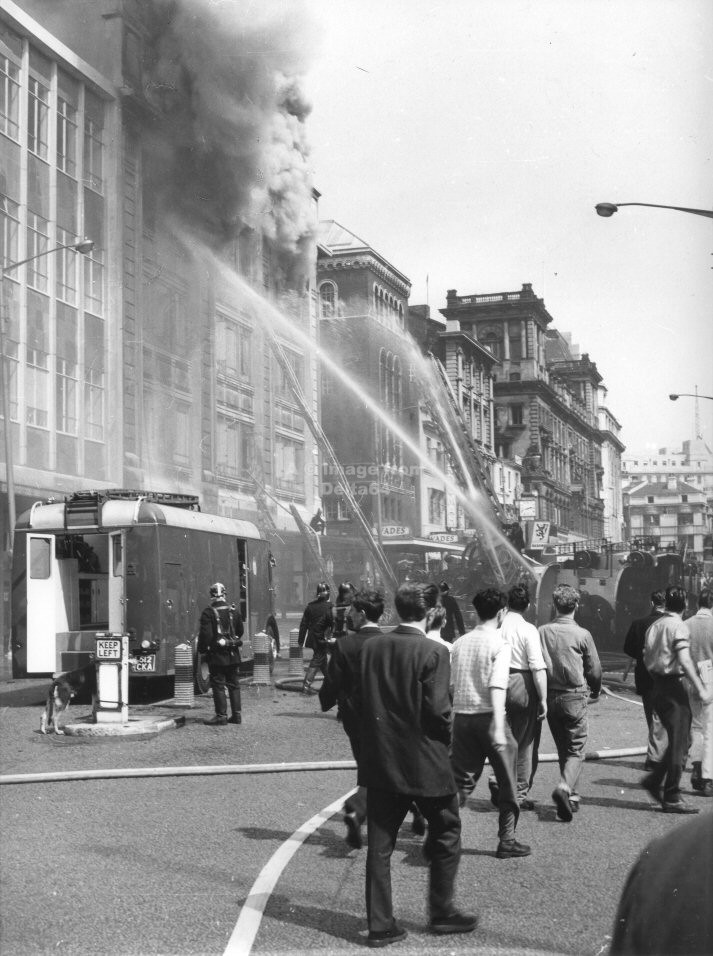
According to the clock to the right of centre, the incident was barely 20 mintues old when this picture was taken.
The rapid spread of fire was unbelieveable. One of the most respected firemen in the brigade, Jimmy Ashcroft, was attending the fire, he was based at Hatton Garden. Jimmy was a man known for his courage, he recalled to the then SubO Frank O`Reilly, 'I was so frightened by the near certainty that I was going to die , that I was crying'. That was the effect the rapid spread of fire coming from the suspended ceiling had on the most experienced firemen.
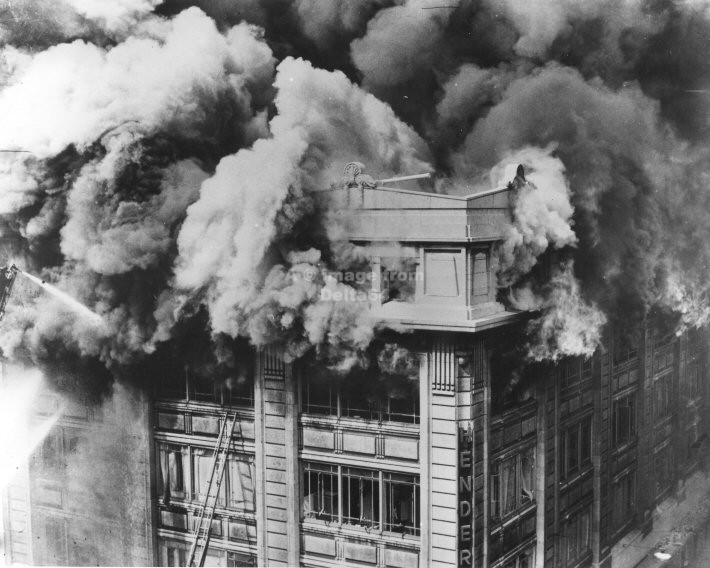
The rush of hot gasses and smoke rapidly spread up the stairs to the 4th floor causing 9 of the 11 deaths.
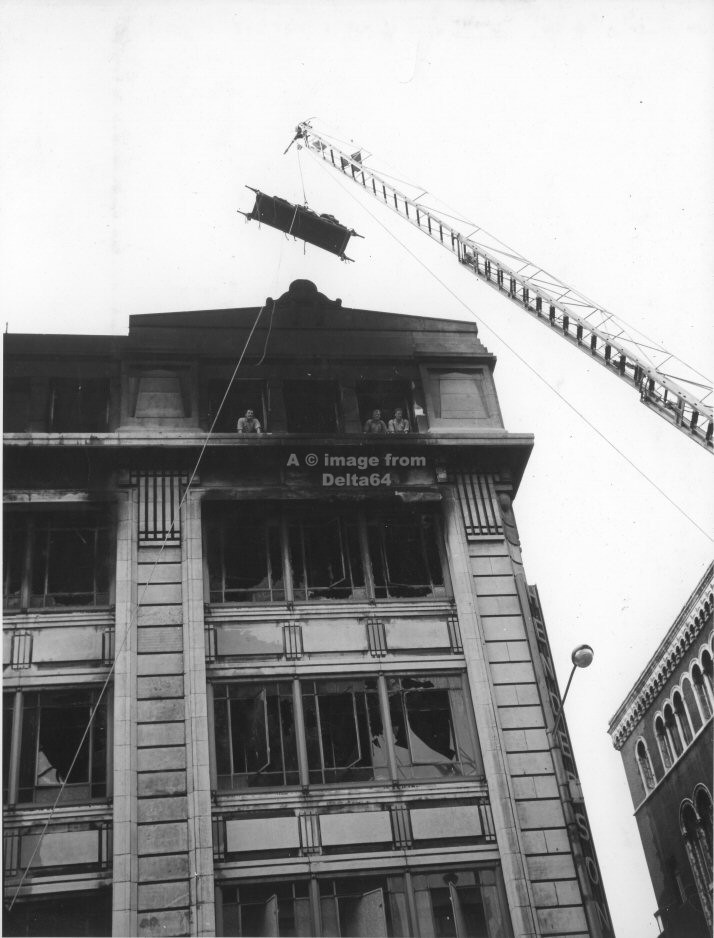
Once the fire had been extinguished, the T.L. was used to recover the bodies from the 4th floor.